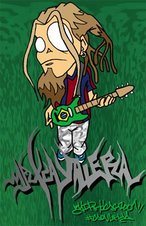I'm going up the country, babe don't you wanna go
I'm going up the country, babe don't you wanna go
I'm going to some place where I've never been before
I'm going, I'm going where the water tastes like wine
Well I'm going where the water tastes like wine
We can jump in the water, stay drunk all the time
I'm gonna leave this city, got to get away
I'm gonna leave this city, got to get away
All this fussing and fighting, man, you know I sure can't stay
Now baby, pack your leaving trunk, you know we've got to leave today
Just exactly where we're going I cannot say, but we might even leave the USA
'Cause there's a brand new game that I want to play
No use of you running, or screaming and crying
'Cause you've got a home as long as I've got mine
This song was created by the leader of the group, Alan "Blind Owl" Wilson. He used to sleep outside, so he could be closer to nature and often carried plant samples around with him in his pockets. He loved to read books on botany and ecology. Wilson was a fanatical conservationist. In 1969, he wrote and recorded a song, "Poor Moon", which expressed concern over potential pollution of the moon. He wrote an essay called 'Grim Harvest', about the coastal redwood forests of California, which was printed as the liner notes to the Future Blues album by Canned Heat.
(Information collected from http://en.wikipedia.org/wiki/Alan_Wilson_(musician), the image is from http://www.blindowl.net/)





2 comments:
Some hippies formed communes to live as far outside of the established system as possible. This aspect of the counterculture rejected active political engagement with the mainstream and, following the dictate of Timothy Leary to "turn on, tune in, and drop out", hoped to change society by dropping out of it.
http://en.wikipedia.org/wiki/Counterculture_of_the_1960s
The back to the land Movement
By the late '60s, many people had recognized that, living their city or suburban lives, they completely lacked any familiarity with such basics of life as food sources (for instance, what a potato plant looks like, or the act of milking a cow) — and they felt out of touch with nature, in general. While the back-to-the-land movement was not strictly part of the counterculture of the 1960s, the two movements had some overlap in participation. Many people were attracted to getting more in touch with the basics just mentioned, but the movement was also fuelled by the "negatives" of modern life: rampant consumerism, the failings of government and society, including the Vietnam War, and a perceived general urban deterioration, including a growing public concern about air and water pollution. Events such as the Watergate scandal and the 1973 energy crisis contributed to these views. Some people rejected the struggle or boredom of "moving up the company ladder." Paralleling the desire for reconnection with nature was a desire to reconnect with physical work, for many were drawn by some sense of dignity in physical labor, just as they might feel depressed contemplating the prospect of a worklife at a desk in the city. There was also a segment within the movement who already had a familiarity with rural life and farming, who already had many skills, and who wanted land of their own on which they could demonstrate that organic farming (rather than conventional) could be made practical and economically successful.
As a general rule, those who "went back to the land" in this period felt neither desirous nor capable of managing a sizable acreage. Many of the smallholdings of the period were in the range of five to 20 acres — though some were smaller and some were larger.
Most of the back-to-the-landers wanted greater contact with nature, and sought to become self-employed workers in a cottage industry. Many wished to build their own house, and produce a good deal of their own food. Solar energy was sometimes used for either heat or electricity, and wood fuel was popular. Most back-to-the-landers wanted to know their neighbors, and some expected to be cooperatively part of neighborhood or community projects and processes. Helen and Scott Nearing, in their life and their books, had embraced organic horticulture and had pursued a healthy diet and general lifestyle. To these interests, the back-to-the-land publications which had sprung up around 1970 added a promotion of new (or at least recently refined) methods of utilizing or generating energy on a modern homestead, such as solar, wind, and small-hydro electricity generation. Worldwide, there had been a very lengthy utilization of wind energy in villages and rural regions, and in fact many farms in North America had employed windmills to drive well pumps for household and irrigation water. In the 1970s, though, electricity-generating wind turbines (which had been developed to an extent in previous decades) were reaching new levels of efficiency. As well, passive solar principles were becoming more widely recognized for their efficacy in space heating (e.g., of houses or outbuildings), and photovoltaic equipment for generating electricity was emerging and was seen to be an exciting new realm.
With regard to community processes, a common practice was the incorporation of barter, a form of trade where goods or services from one individual or household are exchanged for a certain amount of other goods or services from another individual or household, and in which no money is involved in the transaction. The idea was that barter (along with occasional friendly neighborly assistance) helped to reduce the need for cash income.
There is no well-defined event that can be used to mark the end of the era. A factor that came into play was the increased cost of rural land parcels; at the start of the back-to-the-land trend, previously low demand for rural properties in many areas meant that they fetched low prices in the real estate market, but this changed after some years of increased buyer interest. Also, rising urban prosperity, and a sense that the earlier social problems were solved (though we still hear about many of them in the media), led to reduced interest in rural lifestyles among urbanites in the 1980s. Instead, the more focused environmental movement, voluntary simplicity, and renewed interest in outdoor recreation took the place of a relocation to the country. (...) Organic horticulture and organic agriculture were integral aspects of the back-to-the-land movement of the 1970s. But it is in more-recent years that the American market for organically grown foods has really expanded. Growing markets obviously influence business opportunities. According to information presented in Deborah Koons Garcia's film "The Future of Food," American consumers spent $1 billion on organically grown food in 1994, and $13 billion in 2003. Regarding another possible strong trend in the future, it is possible that social or economic conditions, coupled with the new technical capabilities, will result in waves of emigration from the cities and immigration to the rural regions. The worldwide ecovillage movement, while not yet of a scale to be called a "wave," has both urban and rural components that aim at building sustainable village cultures. This global network, along with systematic approaches to ecologically more sensitive design, such as permaculture, have evolved out of the back-to-the-land movement. There are those who see these phenomena as interlinked parts of an agrarian revolution that only began with the back-to-the-land movement of the 1960s & '70s.
http://en.wikipedia.org/wiki/Back_to_the_land
It becomes very obvious from the above quotes of wikipedia that hippies and counterculture enhanced a rural way of life, that in today's terminology can be named "sustainable". Such a way of life is surely promoted politically from nowadays Green Parties worldwide, thus becoming more political than the rather a-political hippies of that era. There is also a strong political aspect in what can be termed "direct democracy", in which every participant of a community is politically active in decision making through general assemblies. This aspect has more to do with the anarcho-communist tradition, especially when it is coupled with the concept of federalizing of the communities (I have especially in m ind the work of Murray Bookchin and his Social Ecology or Communalism). Despite the more mainstream politics of Green Parties, these grassroots radical democratic tendencies still survive within the wider ecological movement and are pregnant with new possibilities and social changes.
Thanks so much for your post, pretty helpful information.
Post a Comment